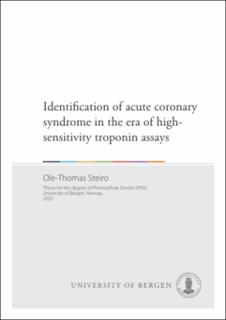| dc.contributor.author | Steiro, Ole-Thomas | |
| dc.date.accessioned | 2023-05-22T06:31:43Z | |
| dc.date.available | 2023-05-22T06:31:43Z | |
| dc.date.issued | 2023-06-02 | |
| dc.date.submitted | 2023-05-15T16:29:27.275Z | |
| dc.identifier | container/93/c9/e5/8f/93c9e58f-4fec-44e3-a7e5-7f0d1476fd55 | |
| dc.identifier.isbn | 9788230843987 | |
| dc.identifier.isbn | 9788230865729 | |
| dc.identifier.uri | https://hdl.handle.net/11250/3068411 | |
| dc.description.abstract | Bakgrunn: Det er mulig å bedre pasientflyt og diagnostisk presisjon ved utredning av pasienter med mistenkt akutt koronarsyndrom (AKS). Konsentrasjonen av kardialt troponin (cTnT eller cTnI) kan benyttes til å forutse langsiktig risiko for kardiovaskulære hendelser dersom visse utfordringer blir avklart, for eksempel om de etablert persentilene innen normalområdet er biologisk like for alle tilgjengelige analyseapparater. Avhandlingen vurderer viktige diagnostiske og prognostiske verktøy i utredningen av pasienter med mulig AKS: troponin-algoritmer, kliniske risikoskalkulatorer og prognostisk betydning av kronisk forhøyede troponin-verdier over 99-percentilen, definert som kronisk myokardskade (KMS).
Metode: Pasienter innlagt på Haukeland Universitetssykehus med symptomer på AKS ble inkludert i WESTCOR-studien (n=1506). Blodprøver ble tatt ved innkomst og etter 3 og 8-12 timer. Artikkel 1 (n=1506) beregner diagnostiske presisjonen for diagnosen NSTEMI basert på brystsmertenes karakter og plassering, og tilleggssymptomer. Artikkel 2 (n=984) vurderer diagnostisk presisjon av troponin-baserte 0/3-timersalgoritmer og 11 ulike risiko-kalkulatorer. Artikkel 3 (n=1147) vurderer prevalens av troponin-verdier over 99-persentilen og prognostisk verdi av KMS sammenlignet mot å bruke lavere troponin-grenser for risikovurdering.
Resultater: Det var små forskjeller mellom kjønn og aldersgrupper i risiko for akutt koronarsykdom basert på spesifikke symptomer. Pasienter med lav risiko for AKS basert på risikokalkulatorer kombinert med lave troponin-konsentrasjoner har svært lav korttidsrisiko for kardiale hendelser. Pasienter med KMS har økt langtidsrisiko for kardiovaskulær død eller uønskede koronare hendelser, men prevalensen av KMS varierer mellom analyseapparater som analyserer cTnT og cTnI.
Konklusjon og implikasjoner: Pasienter med lav risiko for AKS basert på symptomer, kliniske risikokalkulatorer og høy-sensitive troponin-analyser har svært lav kortsiktig risiko for kardiovaskulære hendelser og kan vurderes for tidlig utskrivelse fra sykehus. Klinikere bør være kjent med den forhøyede langtidsrisikoen for fremtidige kardiovaskulære hendelser forbundet med KMS, men også den svake korrelasjonen mellom 99-persentilene for ulike troponin-analyseapparater. | en_US |
| dc.description.abstract | Background: There is potential for future improvements in patient flow and diagnostic precision in patients presenting to hospital with suspected acute coronary syndrome (ACS). Long-term risk of cardiovascular (CV) events may be assessed by cardiac troponin (cTn) levels if certain concerns are addressed and resolved, like whether the established percentiles of normal range are biological equal between all commercially available assays. The thesis evaluates important diagnostic and prognostic tools in cardiac workup of patients with possible ACS: troponin (cTn) algorithms, clinical risk scores, and prognostic relevance of chronically elevated cTn. above the 99th percentile, termed chronic myocardial injury (CMI).
Methods: Patients admitted to Haukeland University Hospital with symptoms suggestive of ACS were included in the WESTCOR study (n=1506). Blood samples were collected at presentation and after 3 and 8-12 hours. Paper 1 (n=1506) calculate the diagnostic precision of chest pain characteristics and additional symptoms for the diagnosis of NSTEMI. Paper 2 (n=984) assess the short-term risk of adverse events when troponin-based 0/3-hour algorithms are combined with 11 different clinical risk scores. Paper 3 (n=1147) evaluate the prevalence of having cTn concentrations above the 99th percentile and long-term prognostic power of CMI compared to using lower cutoff values for risk stratification.
Results: The risk of having an NSTEMI based on specific symptoms were overall similar across sex and age groups. Low-risk patients identified by a risk score combined with low concentrations of cTn have very low short-term risk of adverse cardiac events. Patients with CMI have elevated risk for cardiovascular death and coronary events, but the prevalence of CMI is highly dependent on cTn assay.
Conclusions and implications: Patients classified as low risk based on the presentation of symptoms, clinical risk scores and hs-cTn assays had a very low short-term risk of CV events and could be considered for early discharge from hospital. Physicians should be aware of the increased long-term risk of CV events associated with CMI, but also the low concordance between the 99th percentile URLs of different cTn assays. | en_US |
| dc.language.iso | eng | en_US |
| dc.publisher | The University of Bergen | en_US |
| dc.relation.haspart | Paper I: Steiro O-T, Aakre KM, Tjora HL, Bjorneklett R, Skadberg O, Bonarjee VVS, Mjelva OR, Omland T, MD, Vikenes K, Langorgen J. Association between symptoms and risk of non-ST segment elevation myocardial infarction according to age and sex in patients admitted to the emergency department with suspected acute coronary syndrome: a single-centre retrospective cohort study. BMJ Open. 2022;12:e054185. The article is available in the thesis file. The article is also available at: <a href="http://dx.doi.org/10.1136/bmjopen-2021-054185" target="blank">http://dx.doi.org/10.1136/bmjopen-2021-054185</a> | en_US |
| dc.relation.haspart | Paper II: Steiro O-T, Tjora HL, Langorgen J, Bjorneklett R, Nygard O, Skadberg O, Bonarjee VVS, Lindahl B, Omland T, Vikenes K, Aakre KM. Clinical risk scores identify more patients at risk for cardiovascular events within 30 days as compared to standard ACS risk criteria: the WESTCOR study. European Heart Journal: Acute Cardiovascular Care. 2020 Oct 2;10(3):287–301. The article is available in the thesis file. The article is also available at: <a href="https://doi.org/10.1093/ehjacc/zuaa016" target="blank">https://doi.org/10.1093/ehjacc/zuaa016</a> | en_US |
| dc.relation.haspart | Paper III: Steiro O-T, Langorgen J, Tjora HL, Bjorneklett R, Skadberg O, Bonarjee VVS, Mjelva OR, Steinsvik T, Lindahl B, Omland T, Aakre KM, Vikenes K. Chronic myocardial injury diagnosed by three high-sensitivity cardiac troponin assays; differences in prevalence and prognostic implications. The article is not available in BORA. | en_US |
| dc.rights | In copyright | |
| dc.rights.uri | http://rightsstatements.org/page/InC/1.0/ | |
| dc.title | Identification of acute coronary syndrome in the era of high-sensitivity troponin assays | en_US |
| dc.type | Doctoral thesis | en_US |
| dc.date.updated | 2023-05-15T16:29:27.275Z | |
| dc.rights.holder | Copyright the Author. All rights reserved | en_US |
| dc.contributor.orcid | 0000-0003-2520-9436 | |
| dc.description.degree | Doktorgradsavhandling | |
| fs.unitcode | 13-25-0 | |
